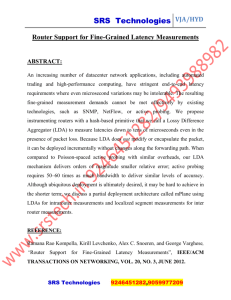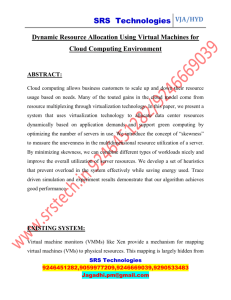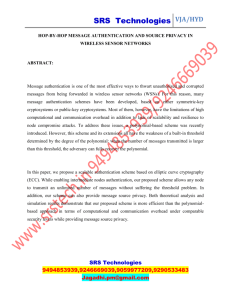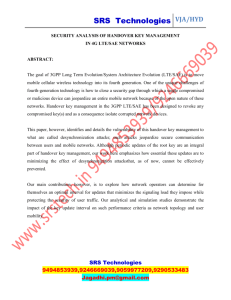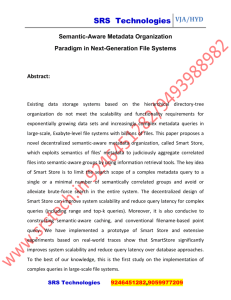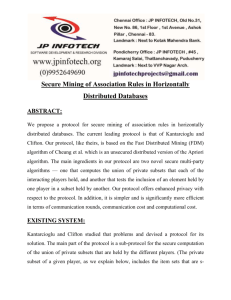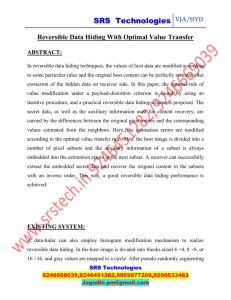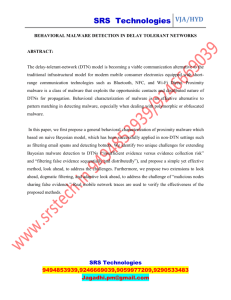subset algorithm
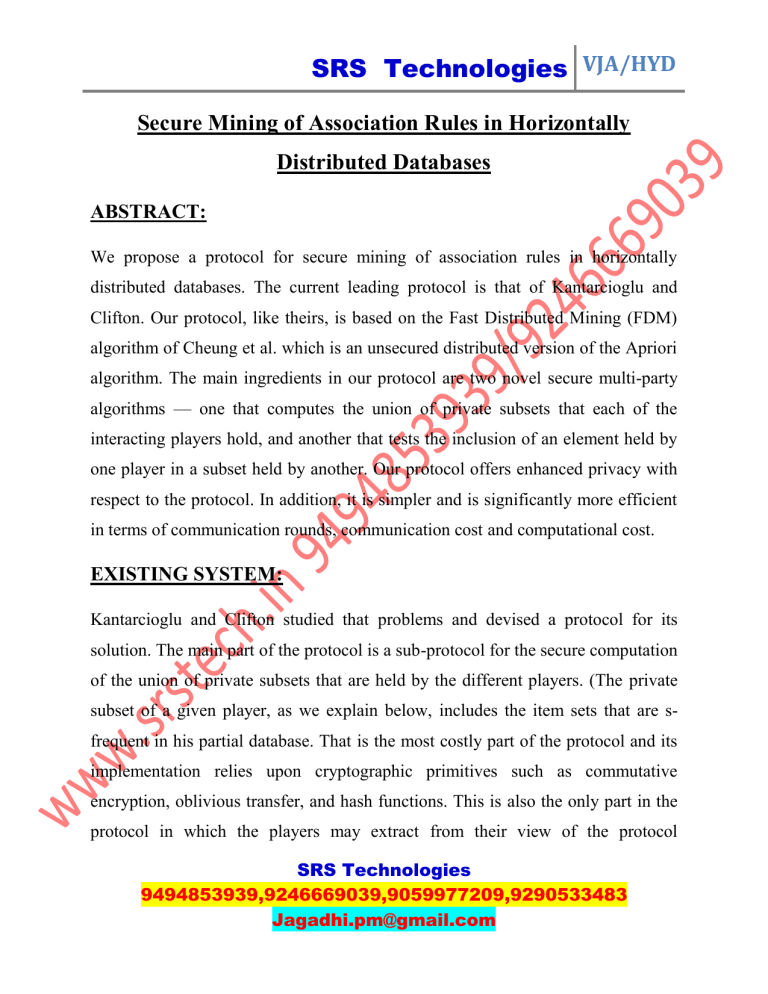
SRS Technologies VJA/HYD
Secure Mining of Association Rules in Horizontally
Distributed Databases
ABSTRACT:
We propose a protocol for secure mining of association rules in horizontally distributed databases. The current leading protocol is that of Kantarcioglu and
Clifton. Our protocol, like theirs, is based on the Fast Distributed Mining (FDM) algorithm of Cheung et al. which is an unsecured distributed version of the Apriori algorithm. The main ingredients in our protocol are two novel secure multi-party algorithms — one that computes the union of private subsets that each of the interacting players hold, and another that tests the inclusion of an element held by one player in a subset held by another. Our protocol offers enhanced privacy with respect to the protocol. In addition, it is simpler and is significantly more efficient in terms of communication rounds, communication cost and computational cost.
EXISTING SYSTEM:
Kantarcioglu and Clifton studied that problems and devised a protocol for its solution. The main part of the protocol is a sub-protocol for the secure computation of the union of private subsets that are held by the different players. (The private subset of a given player, as we explain below, includes the item sets that are sfrequent in his partial database. That is the most costly part of the protocol and its implementation relies upon cryptographic primitives such as commutative encryption, oblivious transfer, and hash functions. This is also the only part in the protocol in which the players may extract from their view of the protocol
SRS Technologies
9494853939,9246669039,9059977209,9290533483
Jagadhi.pm@gmail.com
SRS Technologies VJA/HYD information on other databases, beyond what is implied by the final output and their own input. While such leakage of information renders the protocol not perfectly secure, the perimeter of the excess information is explicitly bounded and it is argued there that such information leakage is innocuous, whence acceptable from a practical point of view.
DISADVANTAGES OF EXISTING SYSTEM:
Insufficient security, simplicity and efficiency are not well in the databases, not sure in privacy in an existing system.
While our solution is still not perfectly secure, it leaks excess information only to a small number (three) of possible coalitions, unlike the protocol of that discloses information also to some single players .
Our protocol may leak is less sensitive than the excess information leaked by the protocol.
PROPOSED SYSTEM:
The protocol that we propose here computes a parameterized family of functions, which we call threshold functions, in which the two extreme cases correspond to the problems of computing the union and intersection of private subsets. Those are in fact general-purpose protocols that can be used in other contexts as well.
Another problem of secure multiparty computation that we solve here as part of our discussion is the set inclusion problem; namely, the problem where Alice holds
SRS Technologies
9494853939,9246669039,9059977209,9290533483
Jagadhi.pm@gmail.com
SRS Technologies VJA/HYD a private subset of some ground set, and Bob holds an element in the ground set, and they wish to determine whether Bob’s element is within Alice’s subset, without revealing to either of them information about the other party’s input beyond the above described inclusion.
ADVANTAGES OF PROPOSED SYSTEM:
We proposed a protocol for secure mining of association rules in horizontally distributed databases that improves significantly upon the current leading protocol in terms of privacy and efficiency.
The main ingredient in our proposed protocol is a novel secure multi-party protocol for computing the union (or intersection) of private subsets that each of the interacting players holds.
MODULES:
1. Privacy Preserving Data Mining
2. Distributed Computation
3. Frequent Itemsets
4. Association Rules
MODULES DESCRIPTION:
1. Privacy Preserving Data Mining:
SRS Technologies
9494853939,9246669039,9059977209,9290533483
Jagadhi.pm@gmail.com
SRS Technologies VJA/HYD
One, in which the data owner and the data miner are two different entities, and another, in which the data is distributed among several parties who aim to jointly perform data mining on the unified corpus of data that they hold. In the first setting, the goal is to protect the data records from the data miner. Hence, the data owner aims at anonym zing the data prior to its release. The main approach in this context is to apply data perturbation. The idea is that. Computation and communication costs versus the number of transactions N the perturbed data can be used to infer general trends in the data, without revealing original record information. In the second setting, the goal is to perform data mining while protecting the data records of each of the data owners from the other data owners.
This is a problem of secure multiparty computation. The usual approach here is cryptographic rather than probabilistic.
2. Distributed Computation:
We compared the performance of two secure implementations of the FDM algorithm Section In the first implementation (denoted FDM-KC), we executed the unification step using Protocol UNIFI-KC, where the commutative cipher was
1024-bit RSA in the second implementation (denoted FDM) we used our Protocol
UNIFI, where the keyed-hash function was HMAC. In both implementations, we implemented Step 5 of the FDM algorithm in the secure manner that was described in later. We tested the two implementations with respect to three measures:
SRS Technologies
9494853939,9246669039,9059977209,9290533483
Jagadhi.pm@gmail.com
SRS Technologies VJA/HYD
1) Total computation time of the complete protocols (FDMKC and FDM) over all players. That measure includes the Apriori computation time, and the time to identify the globally s -frequent item sets, as described in later.
2) Total computation time of the unification protocols only (UNIFI-KC and
UNIFI) over all players. 3) Total message size. We ran three experiment sets, where each set tested the dependence of the above measures on a different parameter:
• N — the number of transactions in the unified database,
3. Frequent Itemsets:
We describe here the solution that was proposed by Kantarcioglu and Clifton.
They onsidered two possible settings. If the required output includes all globally s frequent item sets, as well as the sizes of their supports, then the values of Δ( x ) can be revealed for all. In such a case, those values may be computed using a secure summation protocol, where the private addend of Pm is suppm ( x )
− sNm
. The more interesting setting, however, is the one where the support sizes are not part of the required output. We proceed to discuss it.
4. Association Rules:
Once the set Fs of all s -frequent itemsets is found, we may proceed to look for all
( s, c )-association rules (rules with support at least sN and confidence at least c ). In
SRS Technologies
9494853939,9246669039,9059977209,9290533483
Jagadhi.pm@gmail.com
SRS Technologies VJA/HYD order to derive from Fs all ( s, c )-association rules in an efficient manner we rely upon the straightforward lemma.
SYSTEM REQUIREMENTS:
HARDWARE REQUIREMENTS:
• System : Pentium IV 2.4 GHz.
•
Hard Disk : 40 GB.
•
Floppy Drive : 1.44 Mb.
•
Monitor : 15 VGA Colour.
• Mouse
• Ram
: Logitech.
: 512 Mb.
SOFTWARE REQUIREMENTS:
• Operating system : - Windows XP.
• Coding Language : ASP.NET, C#.Net.
• Data Base : SQL Server 2005
REFERENCE:
SRS Technologies
9494853939,9246669039,9059977209,9290533483
Jagadhi.pm@gmail.com
SRS Technologies VJA/HYD
Tamir Tassa “Secure Mining of Association Rules in Horizontally Distributed
Databases”
IEEE TRANSACTIONS ON KNOWLEDGE AND DATA
ENGINEERING, VOL. 26, NO. 4, APRIL 2014
SRS Technologies
9494853939,9246669039,9059977209,9290533483
Jagadhi.pm@gmail.com
